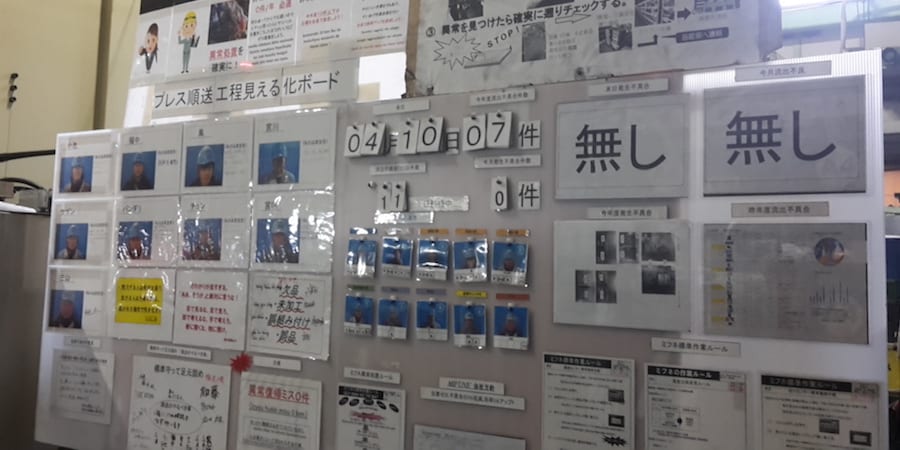
Changing a culture by changing leadership behaviors
FEATURE – We all want to create a lean culture, but what makes cultural change possible? And, more importantly, what are the leadership behaviors that enable a new culture to take root?
Words: Michael Ballé and Klaus Beulker
When we wonder how we can create a lean culture, it is worth clarifying what we mean by culture first. This is one tricky concept, with multiple and completely different meanings. As a result, everyone is sure they know what they mean when they talk about culture, but no one can assume the next person has the same understanding.
A practical way to think about culture is as a set of habits, both behaviors and attitudes, that a group of people share: habits about values (what is good, what is bad); mental models (this reasoning holds true, this one false); tools (we use this tool, not this one); common practices (this is how we all do this, no we don't do it that way here); and preferred solution (we like this solution, we don't like that one). In that concrete sense, lean can indeed be described as a culture:
- Lean has specific values linked to, first, a common goal – customer satisfaction through people development by teaching to see waste and to solve problems to eliminate it – and, second, explicit principles of go and see at the gemba, challenge, kaizen, respect for people and teamwork.
- Lean has very specific and explicit ways of reasoning, such as "reduce lead-time to make problems appear and learn by solving them", "batching (mura) creates overburden (muri), which results in waste (muda)", or "make products one by one in continuous flow to learn how to make things well".
- Obviously lean has specific and uniquely recognizable tools, such as kanban card systems and andon cords, and a variety of problem solving formats (like A3s and problem solving sheets).
- Lean also has specific common practices, such as management gemba walks or team quality circle activities (with structured thinking tools such as 5s, standardized work, SMED, and so on), management-level cross-functional improvement activities ("jishuken"), creative ideas support, and so on.
- Finally, lean has clear preferences for some types of solutions (that put customers before the process; that come from the people themselves; that originate from creative thinking; that better visualize what happens; that make work easier for employees; that improve the product from improving the process without needing much investment; that increase collaboration; that lead to win-win) and a clear dislike for others (such as rigid processes for internal reasons that don't benefit customers; expert designs rolled out over local people's opinions; central systems that don't take context into consideration; large investments without flexibility that make it harder to work well or be motivated; and in general win-lose solutions, even though you might apparently win big).
We can therefore argue that there is such a thing as a "lean culture" – but can we also assume that companies that can develop it actually perform better?
To see the positive impact that lean has on results, we do have enough experience of companies following the basics of a lean culture and then losing that, mostly due to a change in management. We also have evidence of large corporations where various similar sites can be ranked against each other, and it's pretty clear that those with a stronger lean culture perform better.
WHAT MAKES CULTURAL CHANGE POSSIBLE?
If creating a lean culture to improve performance actually makes sense, the question then is "how?" When it comes to lean, what are the main drivers of cultural change?
From a social psychology point of view, the most influential factor is the effect of people looking at what their leaders look at: high-visibility individuals define for others the boundaries of acceptable and not acceptable behavior. One of us (Michael) was lucky to study with Robert King Merton, who coined the term "role model" and showed that most of us unconsciously adapt ourselves to the reference group of people that occupy the social role to which we aspire. Within companies as with society at large, who our leaders are influences disproportionately how everyone else behaves by creating reference points for aspirations. Role models define what we pay attention to and what we ignore.
As COO of a €500-million business unit, one of us (Klaus) has used gemba walks for over a decade as the main tool to model behavior in a very visible way, on the shop floor and in the engineering offices. He says:
"The challenge is that we, as lean leaders, tend to teach tools and preach philosophy. At the beginning of a gemba walk, I must remember myself to stay focused on the people, working conditions, quality of a product or service, and customer expectations. The ideal scenario is having my sensei join me on the gemba walk."
The second key driver is leadership, in terms of the ability of leaders to have followers and to motivate these followers to take action. Beyond some leaders' personal charisma, this has a lot to do with the clarity of the purpose outlined for people and the incentive system of rewards, from praise to promotion, put in place. People will follow leaders that come across as competent (the solutions leaders propose fit with what their followers think is a good solution) and trustworthy (each person feels confident the leader will look out for them and look after them, not just the leader's personal interest). Following leaders creates a drive to put oneself in the leader's good graces and therefore accept (even enforce) the reward/punishment system the leader puts in place. Strong leaders with the wrong agenda can easily lead any group to self-inflicted disaster, precisely because they'll be followed. As a leader, Klaus testifies:
"To be a leader you have also to learn to follow. On the gemba walk I follow my people: I try to stand in their shoes. Only by properly understanding the working conditions they are facing will I be able to lead them. Furthermore, I check that my direct reports are, too, followers: do they follow their people? Do they follow our learning and lean approach? Do they try something in order to explore difficult challenges?"
The third main cultural driver – and the largest source of cultural resistance – is the common use of common tools. Human groups largely define themselves by the arbitrary ways they use specific tools, such as eating with chopsticks or with a knife and fork. Common practices around common tools are a very powerful force of social stickiness, but also a powerful force of social change if an entire group can be persuaded to adopt the new approach/tool/system – as we've recently seen with the widespread adoption of smartphones and social media. Klaus' take:
"In every 1-to-1, my direct report has to present an A3 in order to discuss technical results and problem solving. Furthermore, in our weekly team meeting one of them has to present a solved problem, again based on structured A3 problem solving.
I try to implement visualization and lean tools all over the place at once. If you stick to the tools, sooner or later they will become common practice. It takes between three and eighteen months for this to happen, but in my experience it takes longer if people are not involved from the very beginning."
The fourth, often overlooked, but critical factor is the leader's (or the group's) way of reacting to crises. Because of their emotional nature, crises tend to reveal both our deepest values and knee-jerk reactions. Very often, in a crisis, tactical decisions will later be established as policies without much forward thinking, simply because they felt necessary at the time. Moments of difficulty can either reinforce the existing culture if the reaction is consistent with existing values and behaviors, or steer the culture in a completely different direction if the on-the-spot reaction breaks away from traditional values and behaviors. Some leaders go as far as creating crises, or a sense of crisis, precisely for that reason. In any case, cultures will change at moments of crisis, often in unpredictable ways.
Klaus organizes a team building retreat three times a year to do hansei, self-reflection with and questions to his management team about their reactions to ongoing operational crises and what they achieved.
Fifthly, cultures tend to hinge around perceived competitive advantage. Groups will anchor to deeply-held shared beliefs about what makes them special – which can range from faith to the special use of a tool or social practice, often all three. Cultures are strong when these deep articles of faith are maintained – either because they work or because, even if they evidently don't work, leadership demand for wishful thinking is strong enough – and in flux when these cornerstone beliefs in what makes the group superior to others are weakened. Many leaders, at all levels, from street gangs to nations, grasp this intuitively and demand full adoption of such core beliefs as a ticket to pay for entry in the groups they lead. "We hold these truths to be self-evident..." lies at the core of every culture, for better or worse. For Klaus:
"In a hoshin meeting, where product developments are discussed, people tend to explain timelines and organizational obstacles. This is a great opportunity to ask for technical solutions satisfying the customers more than competition can do. It also gives me the chance to dig into technical questions. In this situation it's extremely obvious that we are busier with managing projects than with supporting customer needs by deeply discussing technical solutions."
AS LEADERS, HOW CAN WE HELP?
With these five forces at play, what can one do as a leader to create a lean culture? What can we transform in ourselves in order to transform the organization around us? Examining each of these five factors, we can come up with uniquely lean personal intentions that will a have disproportionate impact on the culture of the groups we lead:
- Attention: go to the gemba every day, obsessed with how specific features of our products or services get a customer to smile or frown and which processes build these features into the product and how valuable or wasteful they are, and be constantly on the lookout, to learn how improving specific operational processes can improve either the performance (the promise) or the quality (the delivery of the promise) of products and whether that truly satisfies customers. An obsession with product performance and quality for customer satisfaction is the key role model behavior, which will have the largest impact on the lean culture as a whole. Paying too much attention to the organization (be it the "lean" organization) will detract from lean's very purpose.
- Leadership: choosing who to promote is the second critical exercise as who is rewarded with a promotion will impact the rest of the organization and show all others what is expected to be rewarded. Lean has its own tradition of leadership and looks for people who 1) are competent in their field, 2) are confident that others around them can do the work well provided they get the right support, 3) are clear in communicating the "line of sight" – how everyday jobs contribute to the larger purpose, 4) have the courage to face problems and hear unfavorable information from others with and open mind, and 5) the creativity to both encourage original thinking and foster consensus in their teams.
- Common tools and practices: learning to apply imperfect tools wall-to-wall and end-to-end through the supply chain, one tool after next, to create new common practices. This typically involves first setting up a model line to demonstrate how the tools work, but very quickly asking people to try them out and accept that they adopt their own version until progressively creating consensus on the practice. Aiming to quickly have a few basic lean tools applied across the organization is a strong factor of culture change.
- Reaction to crises: striving to turn each crisis into a teachable moment is also a critical part of culture change as crises are unique moments where people will test you to see whether you truly believe what you preach, or are willing to let go of your espoused values when challenged by the crisis. It's hard to keep a cool head when the crisis is for real and the powerful people are incensed and shouting contradictory orders or making impossible demands. Still, crises are – more than anything else – an opportunity to display one's art and to steer the culture one way or the other.
- Competitive advantage: throughout all the daily activities that any leader has to carry out, in the end only one question matters: are we focusing on the points that will deliver competitive advantage or are we letting the organization distract us with ever-day busyness? Improving competencies that deliver competitive advantage and put pressure on competitors has the incredible benefit of creating a space where all employees as well as senior executives can find common ground. By rigorously spotting, choosing and promoting these aspects that do deliver visible benefits, the leader can both anchor the culture he or she is trying to create as well as reassure all people that the company is going in the right direction and that they're right to commit to it.
So, do you really want to create a lean culture? Or did you think that someone else (perhaps a consultant or a lean director) would do it for you? Human endeavors are always, by nature, in flux. Cultures, typically, are in a constant state of tension between their leader's intent – what the leader wants people to focus on and how he or she would like them to behave – and the stickiness of existing habits in terms of common practices and ways of thinking. Changing a culture means having most of the individuals composing this culture switch: change their minds and then strive to change their behavior or, the opposite, change their behavior and then change their minds. Both paths work.
Transforming a culture is hard work. It starts with developing a better understanding of what cultures are and how their internal dynamics play out, because without a deeper grasp of the problem of culture change, one can easily find oneself pushing exactly the wrong buttons and having the opposite effect of the one hoped for.
Culture change is triggered when a critical mass of people want to join your team and have a clear way to do so, mostly by participating in a tool-based practice. The work of culture change is about inspiring people to want to join your project and vision, and creating the practical platforms they can invest themselves in – a difficult step particularly if they're the first to jump in from their immediate peer group. That is why they need to see success, both for themselves in the very short term or for the ideas they joined you to promote. In this, consistent leadership behavior is the ace that wins the hand. To transform your organization and create a lean culture, first you need to transform yourself and become a lean leader.
THE AUTHORS


Read more


FEATURE – In this frank account, a senior executive discusses the challenges facing an oil and gas company as it tries to manage the complexity of its upstream and downstream supply chains.


FEATURE – In this article, you’ll understand how potential errors can become an endless source of personal and managerial growth.


WEB SERIES – Season 2 is here! In the first episode of this season, we visit a company in Chile that shows us how sustainability can be the cornerstone of an improvement project... and not just an afterthought.



NOTES FROM THE GEMBA – This month, the author shares her account of a recent gemba walk at a Tier 2 Toyota supplier, which has achieved impressive results by applying TPS.

